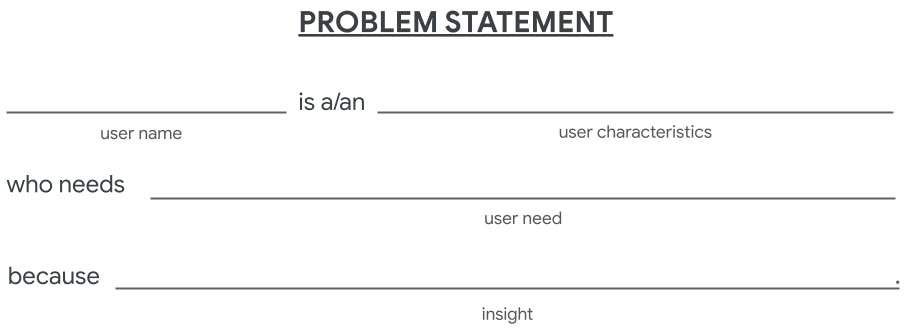[Week 3] Notes on Start the UX Design Process: Empathize, Define, and Ideate
Course 2 of 7 Google's UX Design Professional Certificate by Coursera
Course 2 Week 3 deals with the second part of the product development lifecycle which is Define. This week is one of the shorter ones in terms of reading and video content but that does not make it any less important.
Week 3: Defining User Problems
Problem Statements
- A problem statement is a clear description of the user's needs that should be addressed.
- Identifying the pain points your user is experiencing will help you find potential problems that your design can solve.
- A strong problem statement should be:
- Human-centered
- Broad enough to allow creative freedom
- Narrow enough that it can be solved by a design solution
- A well-written problem statement will help the design team:
- Establish goals
- Understand constraints
- Define deliverables
- Create benchmarks for success
- Formula for creating a problem statement:

- Arnold is a busy executive who needs an easy app experience to hire a dog walker because he's not technologically savvy.
- Amal is an athlete who needs to sign up for workout classes because the class he wants to participate in fills up fast.
The 5 Ws and H: who, what, when, where, why, and how
- The most common framework used to create problem statements is the 5 Ws and H framework.
- Who is experiencing the problem?
- What are the pain points you’re trying to solve?
- Where is the user when they’re using the product?
- When does the problem occur?
- Why is the problem important?
- How are users reaching their goals by using the product?
Hypothesis Statement
- In UX design, we write possible solutions to the problem as hypothesis statements. A hypothesis statement writes out our best, educated guess on what we think the solution to a design problem might be.
2 Hypothesis statements don’t have a single standard formula to follow, but there are two common methods you can try using to write one
- We believe format: We believe that a simplified mode of the dog walker app for Arnold will allow them to hire dog walkers efficiently.
- If / Then format: If Arnold downloads the dog walker app, then they can utilize the “simplified” mode setting to view only the basic app functions.

Value Proposition
- A value proposition is the reason why a consumer should use a product or a service.
- Value propositions ensure that users have a reason to use the product that you are creating, as opposed to any other product currently available.
- It should answer two questions:
- What does your product do? : Clearly explain the offering that your product provides users.
- And why should the user care? : Describe how your product addresses users’ pain points.
- Follow these steps to find out the key value proposition of your product:
- List down all the features and benefits of your product
- Sort the above into something that can provide solve a user's specific problem
- To determine value, take the personas you’ve developed and pair each persona with a value proposition that meets their biggest pain point.
- Review your initial list. The remaining items are your value proposition.
The Human Factor
- The human factor describes the range of variables humans bring to their product interactions.
- In the past, humans had to adjust according to the product. For better UX, we now adapt the product according to the needs of the human.
- Some human factors that inform design are limited concentration, changes in need, needing motivation, prejudices, fears, making errors, misjudgment etc.
TL;DR is a good example of how human shortfalls (small attention spans) require a change in design.
- Psychological concepts that cater to the human factor:
- Mental models: Internal maps that allow humans to predict how something will work. Example: Pulling a door will open it.
- Feedback loops: Outcome a user gets at the end of a process. For example, flipping a light switch will brighten the room, or it won't. Positive feedback would be the light coming on. While negative feedback would be nothing happening.
Psychology and UX
- Von Restorff effect or isolation effect states that when multiple similar objects are present, the one that differs from the rest is most likely to be remembered.
- Example: call-to-action buttons look different from the rest of the buttons on a site or app; because we want them to stand out.
- Serial position effect says that when people are given a list of items, they are more likely to remember the first few and the last few, while the items in the middle tend to blur.
- Example: placing the most important user actions toward the far right or far left of a top navigation bar.
- Hick's law states that the more options a user has, the longer it takes for them to make a decision.
![[Week 3] Notes on Start the UX Design Process: Empathize, Define, and Ideate](https://cdn.hashnode.com/res/hashnode/image/upload/v1667839683829/uSgd4lpzo.png?w=1600&h=840&fit=crop&crop=entropy&auto=compress,format&format=webp)